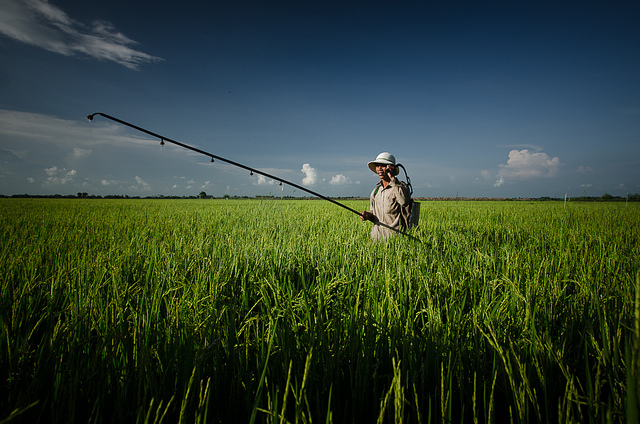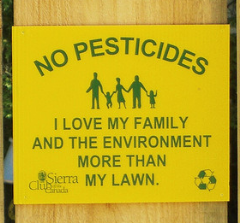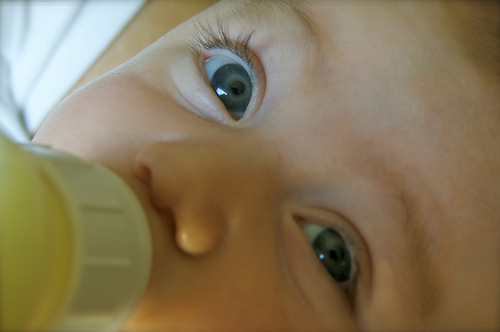Recently, in the first ever testing on glyphosate herbicide (such as Monsanto’s Roundup) in the breast milk of American women, Moms Across America and Sustainable Pulse found ‘high’ levels in 3 out of the 10 samples tested.
(Photo Credit: garyfgarcia via photopin cc)
The shocking results point to glyphosate levels building up in women’s bodies over a period of time, which has until now been refuted by both global regulatory authorities and the biotech industry.
Yet, with the arrival of Spring, so many people will be pulling out the container of Roundup, or some other herbicide, to deal with undesirable weeds. While the advertising says these herbicides are safe for use in our gardens, please consider what the scientific evidence says about its health effects.

Use of herbicides by townships and private landowners is increasingly pervasive as a way to control weeds and invasive plants in our gardens, parks, and public lands. While there is advertising and literature that touts the safeness of glyphosate (glyphosate is the active ingredient in Roundup, Rodeo, and other Monsanto herbicides) there is also peer-reviewed science documenting its known and potential harms, as well as harms from the surfactant ingredients which help the glyphosate penetrate the outer layers of the plant so it can achieve the internal disruption that leads to death.
Herbicides and water quality & wildlife
There are many ways these herbicide can enter streams, rivers and wetlands — by direct application (accidental or otherwise), by drift of the herbicide spray, or as the result of surface runoff. Advocates of the toxic chemicals love to claim that Roundup, Rodeo, and Glyphosate are safe if used around aquatic ecosystems. By contrast, research has shown that “once in the aquatic environment, glyphosate may become toxic to living organisms, including plants, animals and microorganisms.”[1]
It has also been asserted by herbicide advocates that glyphosate, which is designed to kill plants, has only minor effects on animals exposed. But, testing has shown that amphibians, if exposed, can be significantly impacted. One study[2] found “The most striking result from the experiments was that a chemical designed to kill plants killed 98% of all tadpoles within three weeks and 79% of all juveniles within one day.” The study also found that “After 24 hours, the application of Roundup reduced juvenile wood frog survival from 96% to 32% [], juvenile tree frog survival from 100% to 18% [], and juvenile toad survival from 100% to 14%[]. Across all species, only 21% of all juvenile amphibians survived the Roundup application after one day.”
Some of the research shows the toxic effects of Roundup on amphibian larvae may primarily be caused by the surfactant POEA.[3]
Whether the lethal effects of the herbicide Roundup is primarily due to the glyphosate or the surfactant, it is clear that the herbicide called Roundup, with the combination of ingredients it possesses “can cause high rates of mortality in several species of North American Amphibians.” [4]
When pesticides in the environment are compounded by other stressors on aquatic or animal life, such as predation or competition, the effects of the pesticides can become even more lethal. [5]
Public health impacts of residential herbicide use
There continues to be emerging research that demonstrates that glyphosate, some surfactants, and the herbicides containing them, are not safe for humans. At the very least there is science which calls into question the impacts of herbicides for people, animals and our environment.
As with studies in the environment, studies of human effects indicate that it is the glyphosate with the surfactant that has the more toxic effects. Studies have shown glyphosate and its surfactant can have endocrine disrupting affects; that it can induce reproduction problems in placental cells; that it can cause cellular death for a variety of types of human cells; can have toxic affects on embryonic cells; can reduce testosterone levels in testicular cells; and that it is toxic and damaging to mouse marrow. [6]

There are a number of methods that can be taken to ensure that lawns and gardens remain healthy and maintained without using dangerous chemicals. Pesticides are but a short term fix.
There are many chemical products such as PCBs and DDT which were once argued to be safe but in time and with research were proven to be devastatingly harmful. The ”better safe than sorry” motto should be our guiding light in the case of herbicides like those in the glyphosate-based Roundup family where there is claimed scientific proof on both sides of the aisle that we avoid the use of such chemicals, particularly when making decisions that affect the lives of others.
In those limited instances when there may be an overriding reason for herbicide use, such as engaging in a native plant restoration in an area overrun but invasive plants that cannot be eradicated via any other means, be sure to do your homework – make sure you are making the right chemical selection, you are applying it in the most limited amounts effective, that you are wearing proper protective clothing and following all directions for application, and that you keep your children, pets and any wild animals you can away from the area.
Of course, the safest thing to do is go organic on your property.
Rodale Insititute is an excellent source of information for things like organic lawn care and more. Some basic tips for organic lawn and garden care include:
- Recognize which weeds are harmful and which are actually helpful. For instance, clover brings nitrogen for healthy lawns.
- Use natural pesticides including items found in the kitchen pantry. From vinegar to beer, these household items can be utilized to keep away a variety of pests
- Use organic fertilizers and utilize compost – homemade if possible!
- Do research to learn what plants are easiest and best to grow in your environment. Learn about your soil, climate, and common problems among neighboring gardens and yards.
[1] Perez et. al. “Effects of the Herbicide Roundup on Freshwater Microbial Communities: a Mesocosm Study.” Ecological Applications, 17(8), 2007, pp 2310-2322.
[2] Relyea, Rick A. “The Lethal Impact of Roundup on Aquatic and Terrestrial Amphibians.” Ecological Applications, 15(4) pges 1118-1124, 2005.
[3] Relyea, Rick A. “The Lethal Impact of Roundup on Aquatic and Terrestrial Amphibians.” Ecological Applications, 15(4), 2005, pp 1118-1124.
[4] Relyea, Rick A. “The Lethal Impact of Roundup on Aquatic and Terrestrial Amphibians.” Ecological Applications, 15(4), 2005, pp 1118-1124.
[5] Relyea, Rick A. “The Lethal Impact of Roundup on Aquatic and Terrestrial Amphibians.” Ecological Applications, 15(4), 2005, pp 1118-1124.
[6] See e.g. Nora Benachour & Gilles-Eric Seralini, “Glyphosate Formulations Induce Apoptosis and Necrosis in Human Umbilical, Embryonic, and Plancental Cells,” Chem. Res. Toxicol. 2009, 22, 97-105; “Glyphosate Kills Rat Testis Cells, ISIS Report 27/02/12, www.i-sis.org.uk/glyphosate_kills_rat_testis_cells.php; Prasad, S. et al. “Clastogenic Effects of Glyphosate in bone Marrow Cells of Swiss Albino Mice”, Journal of Toxicology, vol 2009, Article ID 308985, 2009; “Glyphosate Kills Rat Testis Cells, ISIS Report 27/02/12, www.i-sis.org.uk/glyphosate_kills_rat_testis_cells.php; Prasad, S. et al. “Clastogenic Effects of Glyphosate in bone Marrow Cells of Swiss Albino Mice”, Journal of Toxicology, vol 2009, Article ID 308985, 2009; Gasnier, C. et al “Glyphosate-based herbicides are toxic and endocrine disruptors in human cell lines”. Toxicology 262, 2009 pp 184-191; Richard, S. et. al, “Differential Effects of Glyphosate and Roundup on Human Placental Cells and Aromatase.” Environmental Health Perspectives, Vol.




